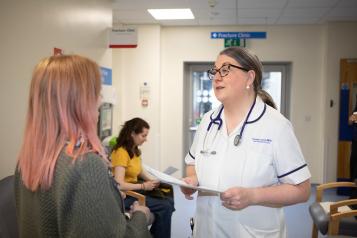Do you still have to wear a face mask? What are the new COVID-19 rules?

What are the new COVID-19 guidelines?
The Government has announced a number of changes to the restrictions designed to help limit the spread of COVID-19.
You should continue to follow safer behaviours to protect yourself and others:
- Get vaccinated and get your booster dose
- Consider wearing a face covering in crowded, enclosed spaces
- Let fresh air in if you meet indoors. Meeting outdoors is safer
- Get tested and self-isolate if required
Which rules have come into force?
-
The Government is no longer asking people to work from home if they can. People should speak to their employers about arrangements for returning to the office, and should follow the Working Safely guidance
-
Face coverings in schools are no longer required for staff and pupils
-
Venues and events are no longer required by law to use the NHS Covid Pass. The NHS Covid Pass can still be used on a voluntary basis as was previously the case in Plan A
-
Face coverings are no longer required by law in any setting. Public health guidance will remain in place, suggesting individuals should continue to wear a face covering in crowded and enclosed spaces, where you may come into contact with people you do not normally meet.
What are the updated guidelines in London?
It is important to note that a face mask is still required on all Tfl services and in bus and train stations.
Some people may not have to wear a face covering. These exemptions apply for age, health and disability reasons.
Face covering exemption badge
People who are not required to wear a face covering can order a free badge from Transport for London to let our staff, enforcement officers and our customers know that they are exempt.
Face covering exemption card
If you are exempt from wearing a face covering, you can download and print the card below and carry it with you. You may want to print it and wear it on a lanyard or attach it to your clothing. You can show it if you are asked why you are not wearing a face covering. We will also recognise similar cards that may have been issued by other transport operators. You can also display it on your phone.
If you do not have a printer or a smartphone, you can contact us and we will print and post a card to you. Call 0343 222 1234 (charges may apply).
Some TfL staff may also use this card.
What are the updated guidelines in for NHS services in Greenwich?
For more information, see restrictions on visiting | Lewisham and Greenwich
General information
All visitors will need to wear a face covering, follow social distancing guidelines and show proof of a negative lateral flow test taken within the last 24 hours to be able to enter. You can order a lateral flow test and register the result on the government website to get proof as a text/email. Alternatively, you can call 119 from 7am to 11pm if it is not possible to use the government website.
Adult inpatients
All adult inpatients, including those having a planned procedure or surgery, can have two named visitors. Visitors should book their visit by calling the ward. Only one named visitor can be at the bedside at any one time. Visits should be limited to one hour.
Pregnant women and birthing partners
- Those giving birth will still be able to bring one birthing partner with them when in labour and on the maternity ward (including the postnatal ward)
- You will be able to attend hospital-based antenatal clinics with one other person
- Babies in the Neonatal Intensive Care wards can still be visited by both parents (or by the mother and their chosen partner) at any time
Children’s wards
- Both parents are permitted to visit children who are inpatients on our paediatric wards.
End-of-life care
- Patients nearing the end of their lives are permitted to have up to four visitors where arrangements can be made safely. This also applies to end-of-life care patients who are being treated in critical care. You must speak to the ward manager in advance to agree how many visitors are permitted, and when the visits can take place. All visitors will need to wear Personal Protective Equipment (PPE) provided by the ward team. A maximum of two visitors can be at the bedside at any one time.
Critical Care Intensive Care Units
- Patients in critical care will be permitted visitors in exceptional circumstances, and at the discretion of the clinical teams caring for them. You must speak to staff in Critical Care in advance to agree the number of visitors and when visits can take place.
What to do when you visit
Face covering/masks: When entering all hospitals you must now wear a face covering and/or mask. If you haven’t brought one with you, our security guards at our main entrances can give you a single use mask. If you are unable to do this, unfortunately you will not be able to visit the patient and will be asked to leave.
Handwashing: When visiting someone in hospital, please wash your hands for 20 seconds using soap and water when entering and leaving the bay or use the alcohol gel provided.
Social distancing: Please keep a safe distance from other patients, visitors and staff where possible. You may need to follow one-way systems to help us all stay apart. If social distancing cannot be maintained in our ward areas, you may be asked to visit at another time.
Personal belongings: Please bring as few personal belongings with you as possible eg bags, electronic devices, gifts.
Outer clothing: Please remove your outer clothing eg coat or jacket and roll up your sleeves before coming onto the ward.
We understand how difficult it is for our patients, relatives and carers at this time. Thank you for working with us to prioritise the safety of our patients, visitors and staff.
Video/phone calls
You can also keep in touch with loved ones by video/phone call rather than coming to visit. Our inpatient wards have access to phones and iPads to support this. Please call the nurse in charge to arrange making contact. You can also send a free patient postcard greeting.
Visiting a care home
COVID-19 restrictions on adult social care will be eased in England from Monday the 31st January.
There will be no limit on the number of visitors allowed at care homes, self-isolation periods will be cut and care homes will have to follow outbreak management rules for 14 days instead of 28 days


